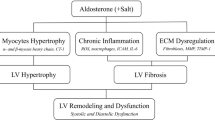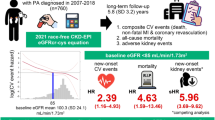Abstract
Primary aldosteronism (PA) has been associated with increased target organ damage (TOD), most likely through mineralocorticoid receptor-dependent endothelial dysfunction, in comparison with essential hypertension (EH). The aim of this study was to evaluate the level of biomarkers of endothelial dysfunction in PA and the relationship with left ventricular hypertrophy (LVH) and microalbuminuria (MAU). A total of 50 PA patients and 51 patients with EH individually matched for age, sex, blood pressure and duration of hypertension participated in this study. Biomarkers of endothelial dysfunction, including von Willebrand factor (vWF), intercellular adhesion molecule 1 (ICAM-1) and oxidized low-density lipoprotein (ox-LDL), were measured. Plasma aldosterone concentration (PAC), MAU and echocardiography were also evaluated. In PA patients, vWF, ICAM-1, ox-LDL, LVH and MAU were all significantly higher than in EH patients (all P<0.05). Furthermore, LVH was positively correlated with PAC (P=0.002), vWF (P=0.013) and ox-LDL (P=0.020). MAU was positively correlated with PAC (P<0.001), vWF (P=0.013) and ICAM-1 (P=0.001). Multiple regression analysis indicated that vWF, ICAM-1 and PAC independently predicted MAU (all P<0.05). Likewise, PAC, vWF and ox-LDL were significant predictors of LVH (all P<0.05). Taken together, our results suggest that endothelial dysfunction may contribute to TOD in PA patients.
This is a preview of subscription content, access via your institution
Access options
Subscribe to this journal
Receive 12 digital issues and online access to articles
$119.00 per year
only $9.92 per issue
Buy this article
- Purchase on Springer Link
- Instant access to full article PDF
Prices may be subject to local taxes which are calculated during checkout
Similar content being viewed by others
References
Mulatero P, Stowasser M, Loh KC, Fardella CE, Gordon RD, Mosso L et al. Increased diagnosis of primary aldosteronism, including surgically correctable forms, in centers from five continents. J Clin Endocrinol Metab 2004; 89: 1045–1050.
Rossi GP, Bernini G, Caliumi C, Desideri G, Fabris B, Ferri C et al. A prospective study of the prevalence of primary aldosteronism in 1,125 hypertensive patients. J Am Coll Cardiol 2006; 48: 2293–2300.
Milliez P, Girerd X, Plouin PF, Blacher J, Safar ME, Mourad JJ et al. Evidence for an increased rate of cardiovascular events in patients with primary aldosteronism. J Am Coll Cardiol 2005; 45: 1243–1248.
Catena C, Colussi G, Nadalini E, Chiuch A, Baroselli S, Lapenna R et al. Cardiovascular outcomes in patients with primary aldosteronism after treatment. Arch Intern Med 2008; 168: 80–85.
Rossi GP, Bernini G, Desideri G, Fabris B, Ferri C, Giacchetti G et al. Renal damage in primary aldosteronism: results of the PAPY Study. Hypertension 2006; 48: 232–238.
Muiesan ML, Salvetti M, Paini A, Bhatia V, Papacosta O, Walker M et al. Inappropriate left ventricular mass in patients with primary aldosteronism. Hypertension 2008; 52: 529–534.
Vita JA . Endothelial function. Circulation 2011; 124: e906–e912.
Nozaki T, Sugiyama S, Koga H, Sugamura K, Ohba K, Matsuzawa Y et al. Significance of a multiple biomarkers strategy including endothelial dysfunction to improve risk stratification for cardiovascular events in patients at high risk for coronary heart disease. J Am Coll Cardiol 2009; 54: 601–608.
Hirono Y, Yoshimoto T, Suzuki N, Sugiyama T, Sakurada M, Takai S et al. Angiotensin II receptor type 1-mediated vascular oxidative stress and proinflammatory gene expression in aldosterone-induced hypertension: the possible role of local renin-angiotensin system. Endocrinology 2007; 148: 1688–1696.
Thum T, Schmitter K, Fleissner F, Wiebking V, Dietrich B, Widder JD et al. Impairment of endothelial progenitor cell function and vascularization capacity by aldosterone in mice and humans. Eur Heart J 2011; 32: 1275–1286.
Funder JW, Carey RM, Fardella C, Gomez-Sanchez C, Mantero F, Stowasser M et al. Case detection, diagnosis, and treatment of patients with primary aldosteronism: an endocrine society clinical practice guideline. J Clin Endocrinol Metab 2008; 93: 3266–3281.
Sahn DJ, DeMaria A, Kisslo J, Weyman A . The Committee on M-mode standardization of the American Society of echocardiography: recommendations regarding quantitation in M-mode echocardiography. Results of a survey of echocardiographic measurements. Circulation 1978; 58: 1072–1083.
Devereux RB, Roman MJ, de Simone G, Weyman A . Relations of left ventricular mass to demographic and hemodynamic variables in American Indians: the Strong Heart Study. Circulation 1997; 96: 1416–1423.
Levey AS, Bosch JP, Lewis JB, Greene T, Rogers N, Roth D . A more accurate method to estimate glomerular filtration rate from serum creatinine: a new prediction equation. Modification of diet in Renal Disease Study Group. Ann Intern Med 1999; 130: 461–470.
Devereux RB, Wachtell K, Gerdts E, Boman K, Nieminen MS, Papademetriou V et al. Prognostic significance of left ventricular mass change during treatment of hypertension. JAMA 2004; 292: 2350–2356.
Vlek AL, van der Graaf Y, Spiering W, Algra A, Visseren FL . Cardiovascular events and all-cause mortality by albuminuria and decreased glomerular filtration rate in patients with vascular disease. J Intern Med 2008; 264: 351–360.
Nishizaka MK, Zaman MA, Green SA, Renfroe KY, Calhoun DA . Impaired endothelium-dependent flow-mediated vasodilation in hypertensive subjects with hyperaldosteronism. Circulation 2004; 109: 2857–2861.
Tsuchiya K, Yoshimoto T, Hirata Y . Endothelial dysfunction is related to aldosterone excess and raised blood pressure. Endocr J 2009; 56: 553–559.
Vita JA, Keaney JF Jr, Larson MG, Keyes MJ, Massaro JM, Lipinska I et al. Brachial artery vasodilator function and systemic inflammation in the Framingham Offspring Study. Circulation 2004; 110: 3604–3609.
Chong AY, Blann AD, Patel J, Freestone B, Hughes E, Lip GY . Endothelial dysfunction and damage in congestive heart failure: relation of flow-mediated dilation to circulating endothelial cells, plasma indexes of endothelial damage, and brain natriuretic peptide. Circulation 2004; 110: 1794–1798.
Lee KW, Blann AD, Lip GY . Inter-relationships of indices of endothelial damage/dysfunction [circulating endothelial cells, von Willebrand factor and flow-mediated dilatation] to tissue factor and interleukin-6 in acute coronary syndromes. Int J Cardiol 2006; 111: 302–308.
Spiel AO, Gilbert JC, Jilma B . von Willebrand factor in cardiovascular disease: focus on acute coronary syndromes. Circulation 2008; 117: 1449–1459.
De Meyer SF, Stoll G, Wagner DD, Kleinschnitz C . von Willebrand factor: an emerging target in stroke therapy. Stroke 2012; 43: 599–606.
Hwang SJ, Ballantyne CM, Sharrett AR, Smith LC, Davis CE, Gotto AM Jr et al. Circulating adhesion molecules VCAM-1, ICAM-1, and E-selectin in carotid atherosclerosis and incident coronary heart disease cases: the Atherosclerosis Risk In Communities (ARIC) study. Circulation 1997; 96: 4219–4225.
Malik I, Danesh J, Whincup P, Bhatia V, Papacosta O, Walker M et al. Soluble adhesion molecules and prediction of coronary heart disease: a prospective study and meta-analysis. Lancet 2001; 358: 971–976.
Cuadrado-Godia E, Ois A, Garcia-Ramallo E . Biomarkers to predict clinical progression in small vessel disease strokes: prognostic role of albuminuria and oxidized LDL cholesterol. Atherosclerosis 2011; 219: 368–372.
Galle J, Hagge TH, Wanner C, Seibold S . Impact of oxidized low density lipoprotein on vascular cells. Atherosclerosis 2006; 185: 219–226.
Iwashima F, Yoshimoto T, Minami I, Hirono Y, Hirata Y . Aldosterone induces superoxide generation via Rac1 activation in endothelial cells. Endocrinology 2008; 149: 1009–1014.
Bauersachs J, Heck M, Fraccarollo D, Hildemann SK, Ertl G, Wehling M et al. Addition of spironolactone to angiotensin-converting enzyme inhibition in heart failure improves endothelial vasomotor dysfunction. J Am Coll Cardiol 2002; 39: 351–358.
Astrup AS, Tarnow L, Pietraszek L, Schalkwijk CG, Stehouwer CD, Parving HH et al. Markers of endothelial dysfunction and inflammation in type 1 diabetic patients with or without diabetic nephropathy followed for 10 years: association with mortality and decline of glomerular filtration rate. Diabetes Care 2008; 31: 1170–1176.
Treasure CB, Klein JL, Vita JA, Manoukian SV, Renwick GH, Selwyn AP et al. Hypertension and left ventricular hypertrophy are associated with impaired endothelium-mediated relaxation in human coronary resistance vessels. Circulation 1993; 87: 86–93.
Steinberg D, Parthasarathy S, Carew TE, Khoo JC, Witztum JL . Beyond cholesterol: modifications of low-density lipoprotein that increase its atherogenicity. New Engl J Med 1989; 320: 915–924.
Afonso L, Hari P, Kondur A, Veeranna V, Manickam P, Simegn M et al. Usefulness of microalbuminuria in patients with the metabolic syndrome to predict subclinical atherosclerosis and cardiovascular disease outcomes. Am J Cardiol 2010; 106: 976–983.
Kuroda YT, Komamura K . Vascular cell adhesion molecule-1 as a biochemical marker of left ventricular mass in the patients with hypertension. Am J Hypertens 2001; 14: 868–872.
Acknowledgements
This study was supported by Grant 81241007 from the National Natural Science Foundation of China.
Author information
Authors and Affiliations
Corresponding author
Ethics declarations
Competing interests
The authors declare no conflict of interest.
Rights and permissions
About this article
Cite this article
Liu, G., Yin, GS., Tang, Jy. et al. Endothelial dysfunction in patients with primary aldosteronism: a biomarker of target organ damage. J Hum Hypertens 28, 711–715 (2014). https://doi.org/10.1038/jhh.2014.11
Received:
Revised:
Accepted:
Published:
Issue Date:
DOI: https://doi.org/10.1038/jhh.2014.11
This article is cited by
-
Screening and diagnosis of primary aldosteronism. Consensus document of all the Spanish Societies involved in the management of primary aldosteronism
Endocrine (2024)
-
The differences of serum lipid profiles between primary aldosteronism and essential hypertension: a meta-analysis and systematic review
BMC Endocrine Disorders (2022)
-
Whole blood methylome-derived features to discriminate endocrine hypertension
Clinical Epigenetics (2022)
-
Long-term impact of spironolactone compliance on microalbuminuria in patients with primary aldosteronism
Hypertension Research (2021)
-
Hypertension outcomes of adrenalectomy in patients with primary aldosteronism: a systematic review and meta-analysis
BMC Endocrine Disorders (2017)



